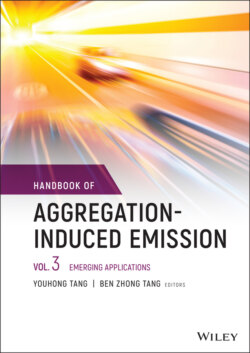Читать книгу Handbook of Aggregation-Induced Emission, Volume 3 - Группа авторов - Страница 18
1.2.3 Red Aggregation‐induced Emissive Emitters
ОглавлениеRed emitters, as one indispensable part of the three‐primary‐color system, play an important role in the full‐color displaying and white‐light emitting systems. Therefore, various AIE emitters with different structures and high efficiency have been prepared and applied in the OLED area [70]. In addition, red AIEgens also found broad applications in biological areas, especially for in vitro and in vivo bioimaging, due to being less detrimental to tissues, deeper penetrating length into tissues, and lower overlapping with background fluorescence, compared with other chromatic emitters [71, 72]. However, compared to AIE luminogens with blue or green emission, the number of red and near infrared (NIR) emissive AIEgens are relatively smaller, and they also share the lower efficiency, due to two reasons: (i) low energy gap of the highest occupied molecular orbital (HOMO) and the lowest unoccupied molecular orbital (LUMO) in the red emitters resulting in high intersystem conversion (IC) and (ii) large dipole moments of donor and acceptor with a high tendency to self‐quench [70]. The red AIE emitters should have lower energy gap, and the main strategies to decrease the energy gap by expanding the π ‐conjugating length and/or strengthening the donor–acceptor interactions. Since most AIE emitters shared much more twisted molecular structure with shorter conjugating length, it could be observed from the red AIE emitters already published that most contained strong donor, such as triphenylamine, and acceptor, such as benzothiadiazole and cyano [73].
The moiety of heterocyclic benzo‐2,1,3‐thiadiazole (TD) was a well‐known building block for red emitters due to its strong electron‐withdrawing properties. Zhao et al. took advantage of TPE, TD, and thiophene building blocks to construct two red emitters BTPETTD and BTPEBTTD (Figure 1.4), with strong built‐in push–pull interactions. OLED devices [ITO/NPB (60 nm)/EML (20 nm)/TPBi (10 nm)/Alq3 (30 nm)/LiF (1 nm)/Al (100 nm)] were fabricated based on these red emitters BTPETTD and BTPEBTTD that exhibited emission at 592 and 668 nm, respectively, with maximum CE, PE, and EQE of 8330 cd/m2, 6.4 cd/A, and 3.1% [74]. Furthermore, they modified BTPEBTTD by attaching an additional TPE unit to the thiophene moiety to obtain the AIE emitter of TTPEBTTD (Figure 1.4), finding a dramatic red‐shift of the emission wavelength. Based on this emitter, the nondoped OLED devices exhibited red emission peaking at 650 nm (CIE = 0.67, 0.32), with CE and EQE of 3750 cd/m2 and 3.7%, which is higher than the BTPEBTTD‐based OLED device, as a result of weakened intermolecular interaction [75]. Xu et al. prepared two new AIE luminogens V2BV2 and T2BT2 (Figure 1.4), composed of TD cores, TPA bridges, and AIE‐active end‐capper. With multiple TPE units, the luminogens exhibited AEE (aggregation‐enhanced emission) properties. The nondoped OLED devices ITO/NPB (60 nm)/sample (20 nm)/TPBi (40 nm)/LiF (1.0 nm)/Al (100 nm) were fabricated with emission of 590 nm for T2BT2 and 616 nm for V2BV2, and the maximum PE was found at 6.81 cd/A and 4.96 lm/W for the T2BT2 device [76]. Qin et al. utilized the moieties of TPE, TD and arylamines triphenyal amine, or N,N′‐di(1‐naphthyl)‐N,N′‐diphenyl‐(1,1′‐biphenyl)‐4,4′‐diamine (NPB) to two novel red AIE‐active emitters TPE‐TPA‐BTD (TTB) and TPE‐NPA‐BTD (TNB) (Figure 1.4), which can be used as EMLs or both HTLs and EMLs for OLEDs with good EL performance. The nondoped OLED based on these emitters as EML can obtain EQE of up to 3.9%, while the bilayer OLED using TTB as HTLs and EMLs can reach EQ of up to 2.5%, with much simpler OLED structure [77]. Wang and coworkers prepared two new red AIE emitters composed by the stronger electron‐deficient core of [1,2,5]thiadiazolo[3,4‐g]quinoxaline or benzo[1,2‐c; 4,5‐c′]bis[1,2,5]thiadiazole and TPE end‐cappers. The resulting luminogens TDQ and BBT (Figure 1.4) show the AEE effect and their films emit NIR PL and EL emissions peaked in the range of 704–883 nm. Efficient nondoped NIR OLEDs were achieved using these materials as emitting layers, with a maximum EQE of 0.89% [78].
Figure 1.4 Molecular structures of red conventional AIE‐active emitters.
